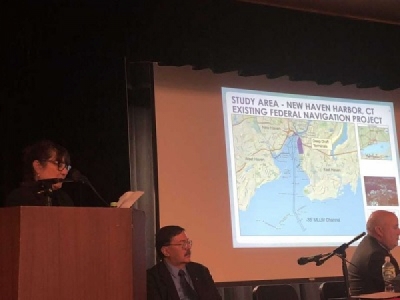
Posted on October 24, 2018
The main shipping channel in New Haven Harbor would be 5 feet deeper and 100 feet wider, enabling larger ships to use New England’s second-largest port, if the plan selected by the Army Corps of Engineers is implemented.
According to the presentation given Tuesday at Bailey Middle School, the rock, silt and sand that would be dug out from the harbor would be put to good use, creating a saltwater marsh north of the sewage-outflow pipe at West Haven’s Sandy Point and an oyster habitat behind the east breakwater in the harbor, among other projects.
Recommended Video
The meeting follows an informational hearing held in January at Nathan Hale School on New Haven’s East Shore.
The channel, last dredged in 1950, would be deepened to 40 feet at the lowest of low tides and widened to 500 feet in the inner channel and 600 feet in the outer channel. The turning basin, needed because of a bend in the channel, would be moved about 200 feet north and enlarged slightly, according to Todd Randall, marine ecologist with the Army corps’ New England District. He said a plan to enlarge the turning basin even more was abandoned because it would involve removing polluted material from the harbor bed.
“The total volume is 4.2 million cubic yards of ordinary dredge material and 43,500 cubic yards of rock,” said Barbara Blumeris, project manager for the corps.
Now the largest ship able to dock at one of the harbor’s seven terminals can draft no more than 31 feet of water without a restriction. That’s because ships need “4 feet of under-keel clearance,” Blumeris said. Larger ships — and the commercial ships bringing in oil, sand, salt and other products are continually growing in size — “have to ride the tide or you have to take material off the ship” before entering the channel, she said.
In recent years, far more ships with drafts greater than 31 feet have delivered cargo — or taken scrap metal to be exported to Turkey, Peru, Egypt or Saudi Arabia — than have those with 31-foot drafts, she said.
Related Stories
Material dredged from harbor project could fill old ‘borrow pit’
Randall listed six sites where the dredged material could go. Since most of the material is silt, it is not usable for beaches, elevating roads or building structures to increase coastal resiliency, he said. Instead some would be placed “behind the east breakwater and … make oyster habitat,” he said. It would “bring the elevation about a foot back up behind the breakwater.”
“All of the blasted rock that comes out of that bend [in the channel] would be placed south of the west breakwater to create a rock reef,” he said.
Other material would be used to fill two “borrow holes,” one of which, outside the mouth of the West River, was just discovered in January. That one could take 80,000 cubic yards of material. The larger one, off Morris Cove, was created when 400,000 cubic yards of seabed were borrowed 60 years ago to build Interstate 95.
Another location would be a 70-acre area “behind Sandy Point to create … a salt marsh environment” with “tidal creeks and rivulets” that would be hospitable to birds, Randall said. Using 840,000 cubic yards of dredged material, it would be north of the sewage outflow pipe, which runs along Sandy Point and needs to be replaced. “We think we can merge their pipe plan … with our area,” Randall said, so that “whichever one comes first [would] be complementary to the other.”
Finally, the Central Long Island Sound Disposal Site, about 6 miles south of the harbor, could be used to dispose of remaining material.
The selected plan would carry an average annual equivalent cost of $3.76 million, and an average benefit of $6.97 million, for a net benefit of $3.2 million, according to the presentation.
Several members of the City Point and West Haven yacht clubs asked that the corps consider dredging the West River up to I-95. Michael Pimer, former harbormaster and member of West Haven’s Harbor Management Commission, pointed out that the Haven high-end outlet mall is planned for the west side of the harbor and said, “You can’t expect folks to go shopping in a big mall if you don’t have water.”
Kathie Hebert, representing the West River Watershed Coalition and the West Haven Watershed Restoration Committee, said members have heard “that there’s an old oyster bed on the New Haven side of the West River” and asked the corps to look into it.
Comments on the draft plan and environmental impact statement may be submitted until Nov. 15. They can be mailed to Randall at U.S. Army Corps of Engineers, New England District, 696 Virginia Road, Concord, Massachusetts 01742-2751. He can be called at 978-318-8518 or emailed at NAE-PD-PN@usace.army.mil.
The plan can be found online at www.nae.usace.army.mil/Missions/Projects-Topics/Ne…
Another hearing will be held at 6:30 p.m. Wednesday at the New Haven Hall of Records, 200 Orange St. The New Haven Port Authority and the Connecticut Port Authority are non-federal partners in the project.
Source: Chron





